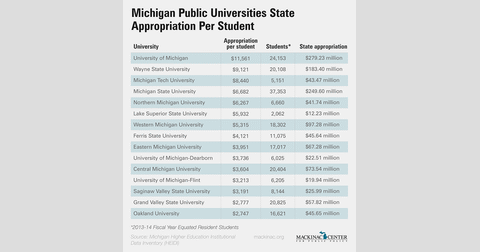Fix Disparities in Public University Funding in Michigan
The way the state spends $1.5 billion on higher education is unfair
Editor's Note: This article first ran in Bridge Magazine.
There has been a lot of talk recently about closing the foundation allowance gap between K-12 school districts in Michigan. This gap effectively ranges from $7,251 to $8,099 per pupil.
But what about closing the funding disparity among Michigan public universities? The gap is huge: Funding for the state’s 15 public universities ranges from $2,747 to $11,561 per student.
The bulk of federal funding universities in Michigan receives is in the form of Pell Grants, which are awarded to students based on their financial need which they use for the school that they wish. Other federal funding comes via grants that universities have to apply and compete for.
The state, on the other hand, largely funds universities through an appropriation process that is largely arbitrary. And this is real money: Gov. Snyder’s budget calls for spending more than $1.5 billion on public universities next fiscal year.
Beginning in fiscal year 2012-13, the state did finally begin to consider some important factors when deciding how to allocate university spending. But much more needs to be done.
In 2013-14, universities received 50 percent of the appropriation based on what they’ve historically been given — which means half of state funding isn’t based on anything important. Of the remaining, 11 percent is based on graduating students in areas of “critical skills” (a wide range of areas). Roughly 6 percent of funding is for “research and development expenditures” (which leaves out eight public universities).
The remaining 33 percent of the state funding appropriated is based on four areas where Michigan universities are judged against their national peers. This includes the six-year graduation rate, total number of degrees, administrative efficiency, and the total number of Pell grant students.
While this is better than the totally random way funding was given out in the past, there are still problems. The formula is flawed, basing only a small percentage of state funding on things that actually matter.
Grand Valley State University scores second-highest on the state’s “performance funding” measurements and Wayne State University scores the lowest. By most objective measures, the former is doing a better job than the latter — but WSU still gets far more money from taxpayers.
Consider that Wayne State (20,108) and Grand Valley (20,825) have nearly the same number of resident full-time students — but the former receives more than three times as much money ($191.1 million compared to $64.4 million).
The six-year graduation rate at GVSU is 66 percent compared to 28 percent at WSU. The average student tuition paid per degree awarded at GVSU is $63,722 while Wayne State takes in over $108,000 in tuition per bachelor’s degree.
When the university the state says is doing the second-best in providing value to students is receiving among the least amount of funding per student, there’s something wrong with the formula.
The state currently does a poor job in determining how much money each university should get. A better path would be to simply give each Michigan student attending a public university a set amount of money to attend where they wish. This would be a much fairer system — each student, no matter which public university they choose to attend, will have the exact same level of taxpayer support. Attaching a performance kicker — a bonus if a student actually graduates — would be even better.
The college receiving the median amount from the state is Ferris State University which gets $4,121 per pupil in taxpayer funds. If Michigan funded its other public universities at this rate per students, it would save more than $600 million.
Universities always push back when the Legislature wants to base more of higher education on real performance measures. But when taxpayers are spending over $1.5 billion, there should be metrics in place that ensure it is being spent efficiently. The state has failed in this and it is time for a change.
Michigan Capitol Confidential is the news source produced by the Mackinac Center for Public Policy. Michigan Capitol Confidential reports with a free-market news perspective.


 Michigan manages to lose students while hiking higher ed spending
Michigan manages to lose students while hiking higher ed spending
 MSU loses claim that student privacy trumps transparency law
MSU loses claim that student privacy trumps transparency law
 Students at Michigan colleges receive varying state support
Students at Michigan colleges receive varying state support